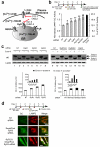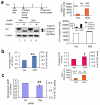Endoplasmic reticulum Ca2+ increases enhance mutant glucocerebrosidase proteostasis
- PMID: 20453863
- PMCID: PMC2873071
- DOI: 10.1038/nchembio.368
Endoplasmic reticulum Ca2+ increases enhance mutant glucocerebrosidase proteostasis
Erratum in
- Nat Chem Biol. 2010 Aug;6(8):630
Abstract
Altering intracellular calcium levels is known to partially restore mutant enzyme homeostasis in several lysosomal storage diseases, but why? We hypothesized that endoplasmic reticulum (ER) calcium increases enhance the folding, trafficking and function of these mutant misfolding- and degradation-prone lysosomal enzymes by increasing chaperone function. Here we report that increasing ER calcium levels by reducing ER calcium efflux through the ryanodine receptor, using antagonists or RNAi, or by promoting ER calcium influx by SERCA2b overexpression enhances mutant glucocerebrosidase (GC) homeostasis in cells derived from individuals with Gaucher's disease. Post-translational regulation of the calnexin folding pathway by an elevated ER calcium concentration seems to enhance the capacity of this chaperone system to fold mutant misfolding-prone enzymes, increasing the folded mutant GC population that can engage the trafficking receptor at the expense of ER-associated degradation, increasing the lysosomal GC concentration and activity.
Figures






Comment in
-
Manipulating proteostasis.Nat Chem Biol. 2010 Jun;6(6):400-1. doi: 10.1038/nchembio.374. Nat Chem Biol. 2010. PMID: 20479748 No abstract available.
Similar articles
-
ERdj3 is an endoplasmic reticulum degradation factor for mutant glucocerebrosidase variants linked to Gaucher's disease.Chem Biol. 2014 Aug 14;21(8):967-76. doi: 10.1016/j.chembiol.2014.06.008. Chem Biol. 2014. PMID: 25126989 Free PMC article.
-
Ca2+ homeostasis modulation enhances the amenability of L444P glucosylcerebrosidase to proteostasis regulation in patient-derived fibroblasts.ACS Chem Biol. 2011 Feb 18;6(2):158-68. doi: 10.1021/cb100321m. Epub 2010 Nov 10. ACS Chem Biol. 2011. PMID: 21043486
-
Remodeling the proteostasis network to rescue glucocerebrosidase variants by inhibiting ER-associated degradation and enhancing ER folding.PLoS One. 2013 Apr 19;8(4):e61418. doi: 10.1371/journal.pone.0061418. Print 2013. PLoS One. 2013. PMID: 23620750 Free PMC article.
-
Gaucher disease paradigm: from ERAD to comorbidity.Hum Mutat. 2012 Oct;33(10):1398-407. doi: 10.1002/humu.22124. Epub 2012 Jun 11. Hum Mutat. 2012. PMID: 22623374 Review.
-
The relationship between glucocerebrosidase mutations and Parkinson disease.J Neurochem. 2016 Oct;139 Suppl 1(Suppl Suppl 1):77-90. doi: 10.1111/jnc.13385. Epub 2016 Feb 10. J Neurochem. 2016. PMID: 26860875 Free PMC article. Review.
Cited by
-
Quantitative Measurement of Transthyretin Mistargeting by Proximity Labeling and Parallel Reaction Monitoring.Front Chem Biol. 2023;2:1288188. doi: 10.3389/fchbi.2023.1288188. Epub 2023 Nov 9. Front Chem Biol. 2023. PMID: 38173467 Free PMC article.
-
How to fix a broken protein: restoring function to mutant human cystathionine β-synthase.Hum Genet. 2022 Jul;141(7):1299-1308. doi: 10.1007/s00439-021-02386-w. Epub 2021 Oct 12. Hum Genet. 2022. PMID: 34636997 Free PMC article. Review.
-
Disturbance of endoplasmic reticulum proteostasis in neurodegenerative diseases.Nat Rev Neurosci. 2014 Apr;15(4):233-49. doi: 10.1038/nrn3689. Epub 2014 Mar 12. Nat Rev Neurosci. 2014. PMID: 24619348 Review.
-
ERdj3 is an endoplasmic reticulum degradation factor for mutant glucocerebrosidase variants linked to Gaucher's disease.Chem Biol. 2014 Aug 14;21(8):967-76. doi: 10.1016/j.chembiol.2014.06.008. Chem Biol. 2014. PMID: 25126989 Free PMC article.
-
Endoplasmic Reticulum Malfunction in the Nervous System.Front Neurosci. 2017 Apr 25;11:220. doi: 10.3389/fnins.2017.00220. eCollection 2017. Front Neurosci. 2017. PMID: 28487627 Free PMC article.
References
-
- Balch WE, Morimoto RI, Dillin A, Kelly JW. Adapting proteostasis for disease intervention. Science. 2008;319:916–919. - PubMed
-
- Deuerling E, Bukau B. Chaperone-assisted folding of newly synthesized proteins in the cytosol. Crit. Rev. Biochem. Mol. Biol. 2004;39:261–277. - PubMed
-
- Bukau B, Weissman J, Horwich A. Molecular chaperones and protein quality control. Cell. 2006;125:443–451. - PubMed
Publication types
MeSH terms
Substances
Grants and funding
LinkOut - more resources
Full Text Sources
Other Literature Sources
Miscellaneous

